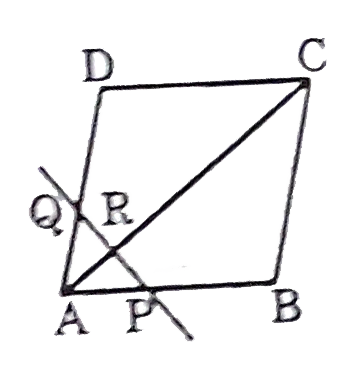In a triangle AOB, R and Q are the points on the side OB and AB respectively such that 3OR = 2RB and 2AQ = 3QB. Let OQ and AR intersect at the point P (where O is origin).
Q. If the point P divides OQ in the ratio of μ:1, then μ is :
219
217
215
109
The correct Answer is:D
To solve the problem, we need to find the ratio μ:1 in which point P divides line segment OQ. We will use the concept of section formula and vector representation.
1. Understanding the Triangle and Points:
- Let O be the origin, A and B be points in the plane.
- Let R be a point on line segment OB such that 3OR=2RB.
- Let Q be a point on line segment AB such that 2AQ=3QB.
2. Finding the Position Vector of R:
- Since R divides OB in the ratio 2:3, we can use the section formula:
→R=3→O+2→B3+2=3→0+2→B5=2→B5
3. Finding the Position Vector of Q:
- Since Q divides AB in the ratio 3:2, we can again use the section formula:
→Q=2→A+3→B2+3=2→A+3→B5
4. Finding the Position Vector of P:
- Let P divide OQ in the ratio μ:1. By the section formula:
→P=μ→Q+1⋅→Oμ+1=μ→Qμ+1
- Substituting →Q:
→P=μ(2→A+3→B5)μ+1=2μ→A+3μ→B5(μ+1)
5. Finding the Position Vector of P Using AR:
- Now, we also need to express P in terms of A and R. Let P divide AR in some ratio k:1:
→P=k→R+1→Ak+1
- Substituting →R:
→P=k(2→B5)+→Ak+1=2k→B5+→Ak+1
6. Equating the Two Expressions for →P:
- We have two expressions for →P:
2μ→A+3μ→B5(μ+1)=2k→B5+→Ak+1
- Cross-multiplying gives:
(2μ→A+3μ→B)(k+1)=(2k→B+5→A)(μ+1)
7. Expanding and Rearranging:
- Expanding both sides:
2μk→A+2μ→A+3μk→B+3μ→B=2kμ→B+5μ→A+2k→B+5→A
- Rearranging gives us a system of equations.
8. Solving for μ:
- By equating coefficients of →A and →B, we can solve for μ and k.
- After simplification, we find:
μ=109
Final Answer:
Thus, the value of μ is 109.
- Let O be the origin, A and B be points in the plane.
- Let R be a point on line segment OB such that 3OR=2RB.
- Let Q be a point on line segment AB such that 2AQ=3QB.
- Since R divides OB in the ratio 2:3, we can use the section formula:
→R=3→O+2→B3+2=3→0+2→B5=2→B5
- Since Q divides AB in the ratio 3:2, we can again use the section formula:
→Q=2→A+3→B2+3=2→A+3→B5
- Let P divide OQ in the ratio μ:1. By the section formula:
→P=μ→Q+1⋅→Oμ+1=μ→Qμ+1
- Substituting →Q:
→P=μ(2→A+3→B5)μ+1=2μ→A+3μ→B5(μ+1)
- Now, we also need to express P in terms of A and R. Let P divide AR in some ratio k:1:
→P=k→R+1→Ak+1
- Substituting →R:
→P=k(2→B5)+→Ak+1=2k→B5+→Ak+1
- We have two expressions for →P:
2μ→A+3μ→B5(μ+1)=2k→B5+→Ak+1
- Cross-multiplying gives:
(2μ→A+3μ→B)(k+1)=(2k→B+5→A)(μ+1)
- Expanding both sides:
2μk→A+2μ→A+3μk→B+3μ→B=2kμ→B+5μ→A+2k→B+5→A
- Rearranging gives us a system of equations.
- By equating coefficients of →A and →B, we can solve for μ and k.
- After simplification, we find:
μ=109
Thus, the value of μ is 109.
Topper's Solved these Questions
- VECTOR & 3DIMENSIONAL GEOMETRYBOOK - VK JAISWAL ENGLISHCHAPTER - VECTOR & 3DIMENSIONAL GEOMETRYEXERCISE - Exercise-5 : Subjective Type Problems
13 Videos
- VECTOR & 3DIMENSIONAL GEOMETRYBOOK - VK JAISWAL ENGLISHCHAPTER - VECTOR & 3DIMENSIONAL GEOMETRYEXERCISE - Exercise-2 : One or More than One Answer is/are Correct
19 Videos
- TRIGONOMETRIC EQUATIONS BOOK - VK JAISWAL ENGLISHCHAPTER - TRIGONOMETRIC EQUATIONS EXERCISE - Exercise-5 : Subjective Type Problems
9 Videos
Similar Questions
In a triangle ABC , let P and Q be points on AB and AC respectively such that PQ∣∣BC . Prove that the median AD bisects PQ.
View SolutionIn the given triangle P, Q and R are the mid points of sides AB, BC and AC respectively. Prove that triangle PQR is similar to triangle ABC.

View SolutionIn ΔPQR, if PQ=QR and L,M and N are the mid-points of the sides PQ,QR and RP respectively. Prove that LN=MN.
View SolutionP,Q,R are the points on the sides AB, BC and CA respectively of triangle ABC such that AP:PB=BQ:QC=AR:RC=1:2. Show that PBQR is a parallelogram.
View SolutionD, E and F are the mid-points of the sides AB, BC and CA respectively of A ABC. AE meets DF at O. P and Q are the mid-points of OB and OC respectively. Prove that DPOF is a parallelogram.
View SolutionIf the points P,Q,R,S are (4,7,8),(−1,−2,1),(2,3,4)and(1,2,5) respectively show that PQ and RS intersect. Also find the point of intersection.
View SolutionLet P and Q be any two points on the lines represented by 2x−3y=0 and 2x+3y=0 respectively. If the area of triangle OPQ (where O is origin) is 5, then which of the following is not the possible equation of the locus of mid-point of PO?
View SolutionIf points Q and R reflections of point P(−3, 4) in X and Y axes respectively, what is QR ?
View SolutionA transversal cuts side AB and AD and diagonal AC of parallelogram ABCD in points P,Q and R respectively such that AP: PB =1 :2 and AQ: QD=2:3 . Find the ratio AR : RC

View SolutionA(2,3) is a fixed point and Q(3cosθ,2sinθ) a variable point. If P divides AQ internally in the ratio 3:1, find the locus of P.
View Solution
